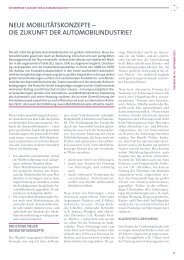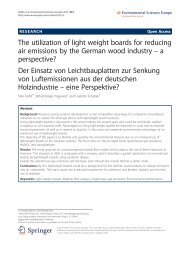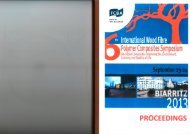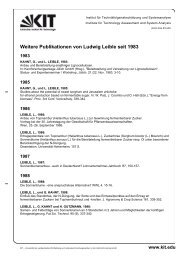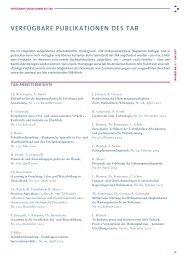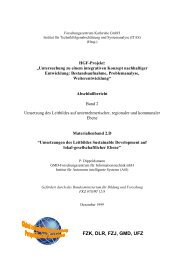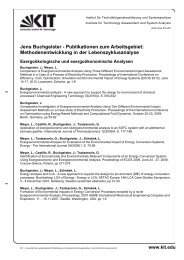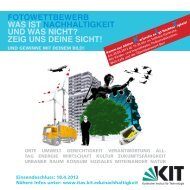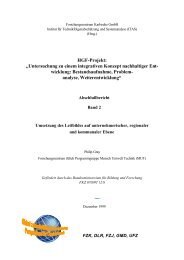Results: RFID and Identity Management in everyday life - ITAS
Results: RFID and Identity Management in everyday life - ITAS
Results: RFID and Identity Management in everyday life - ITAS
Create successful ePaper yourself
Turn your PDF publications into a flip-book with our unique Google optimized e-Paper software.
All <strong>in</strong> all, there is not much go<strong>in</strong>g on concern<strong>in</strong>g <strong>Identity</strong> <strong>Management</strong> when we go shopp<strong>in</strong>g. Perhaps<br />
because it were <strong>in</strong> fact these sett<strong>in</strong>gs <strong>in</strong> which the first big controversies emerged, not only <strong>in</strong> Germany<br />
but also <strong>in</strong> the US, the sector became very cautious l<strong>in</strong>k<strong>in</strong>g <strong>RFID</strong> to customers identity. For now we<br />
are done shopp<strong>in</strong>g <strong>and</strong> it’s time to have some fun. We can go to a theme park, football match or a<br />
night club, to discover <strong>RFID</strong> is sometimes used to track us as crowds, but also to give us personalised<br />
privileges.<br />
Hav<strong>in</strong>g fun: privileged persons <strong>and</strong> tracked masses<br />
The leisure sector turned out to be the most surpris<strong>in</strong>g <strong>in</strong> our research. Other than <strong>in</strong> retail, we<br />
encountered many <strong>in</strong>terest<strong>in</strong>g stories on <strong>Identity</strong> <strong>Management</strong>, some be<strong>in</strong>g widely discussed <strong>in</strong> the<br />
media, while others only unfold<strong>in</strong>g with<strong>in</strong> the secured boundaries of the leisure sett<strong>in</strong>g.<br />
One case receiv<strong>in</strong>g some media attention is the LEGO l<strong>and</strong> KidSpotter [case #36] <strong>in</strong> Billund,<br />
Denmark. At the entrance of the park, parents can rent a wristb<strong>and</strong> conta<strong>in</strong><strong>in</strong>g an active <strong>RFID</strong> for their<br />
children for € 3,- a day. Throughout the 150.000 square meters park about 40 to 50 <strong>RFID</strong> readers are<br />
placed. If the parents lose sight of their child, they can send an SMS message to the KidSpotter<br />
system. They will receive a return message stat<strong>in</strong>g the name of the park area <strong>and</strong> the map coord<strong>in</strong>ate of<br />
their child's position <strong>in</strong> the park with an accuracy of 3 meters.<br />
This security function is the ma<strong>in</strong> reason for parent rent<strong>in</strong>g the wristb<strong>and</strong>, counter<strong>in</strong>g the problem that<br />
about 1600 children get lost <strong>in</strong> the park annually. <strong>Identity</strong> <strong>Management</strong> <strong>in</strong> this case <strong>in</strong>volves a<br />
comb<strong>in</strong>ation of personal identity, place <strong>and</strong> phone number. Some newspapers hypothesised parents<br />
could also just drop off their children at the park <strong>and</strong> go shopp<strong>in</strong>g elsewhere, trust<strong>in</strong>g their children<br />
would be conf<strong>in</strong>ed with<strong>in</strong> the area, but we are not sure this actually happens.<br />
From the parks po<strong>in</strong>t of view, another <strong>Identity</strong> <strong>Management</strong> opportunity arises: track<strong>in</strong>g the flow of<br />
visitors through the park. The readers divide the park up <strong>in</strong>to a number of areas <strong>and</strong> the database<br />
shows the number of people <strong>in</strong> each area <strong>and</strong> how many move from one area to another. This is<br />
valuable <strong>in</strong>formation, for <strong>in</strong>stance for the market<strong>in</strong>g or cater<strong>in</strong>g departments. We contacted several<br />
spokespeople at LEGO l<strong>and</strong>, but none of them was will<strong>in</strong>g to give us more details on <strong>Identity</strong><br />
<strong>Management</strong> issues <strong>in</strong> the park. One even claimed the system was ab<strong>and</strong>oned, but accord<strong>in</strong>g to its<br />
provider, KidSpotter, it was not. We therefore went to a theme park <strong>in</strong> the Netherl<strong>and</strong>s which also<br />
tracks visitors with active <strong>RFID</strong>, but this time without them know<strong>in</strong>g.<br />
The Apenheul [case #130] is a zoo specialised <strong>in</strong> all k<strong>in</strong>ds of apes <strong>and</strong> monkeys. An outst<strong>and</strong><strong>in</strong>g<br />
feature of the park is the opportunity for some k<strong>in</strong>ds of monkeys to move freely through the crowd of<br />
visitors. Curious as they are, the monkeys often try to open visitors’ bags <strong>in</strong> hope of a free lunch. The<br />
park therefore <strong>in</strong>troduced the “Monkey bag”, a green bag with an extra clip lock which monkeys<br />
cannot open. The bag is obligatory, which is enforced by the receptionists provid<strong>in</strong>g the bag at the<br />
entrance of the park <strong>and</strong> a warn<strong>in</strong>g sign. Aside from this security reason for implement<strong>in</strong>g the bag, the<br />
department of market<strong>in</strong>g added a market<strong>in</strong>g feature to the bag: scann<strong>in</strong>g visitors movements through<br />
the park through an active <strong>RFID</strong> sewn <strong>in</strong>to the bag.<br />
Currently about 200 of the 3000 bags are tagged. In order to provide a representative sample of<br />
visitors, the tagged bags are h<strong>and</strong>ed out r<strong>and</strong>om, add<strong>in</strong>g to 1 <strong>in</strong> 15 visitors tracked. A dataset of 90.000<br />
read<strong>in</strong>gs provided the data to analyse for visitors flows. If for example an area receives too few<br />
visitors, it presumably needs to be made more attractive. If the area receives the most visitors, it’s<br />
probably a hit. Also, if visitors demonstrate a pattern of “gett<strong>in</strong>g lost”, e.g. mov<strong>in</strong>g back <strong>and</strong> forth a lot<br />
between two areas, the directions need to be changed. F<strong>in</strong>ally the overview of visitor flows can detect<br />
congestion spots that need to be relieved.<br />
21



